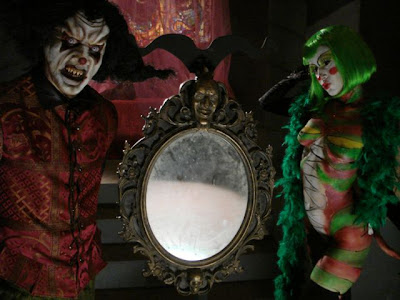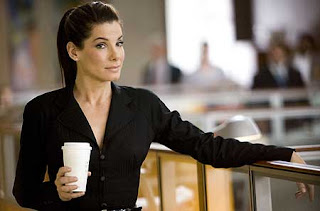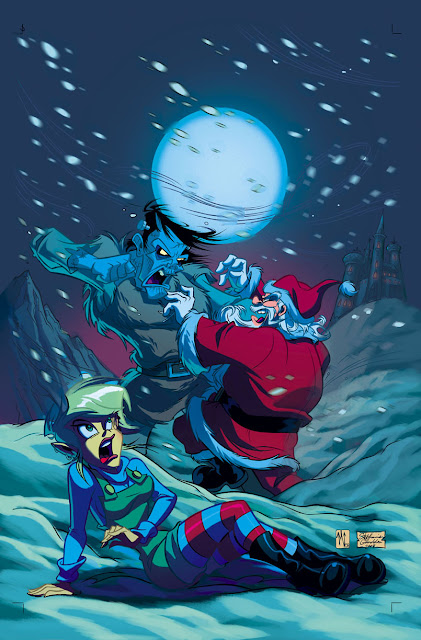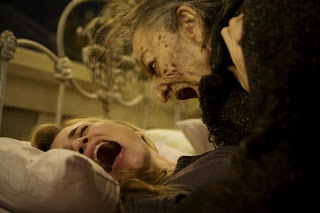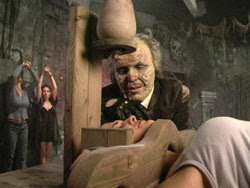Starring: Trent Haaga, Spiral Jackson, Jessica Whitaker, Darrow Igus, Victoria De Mare, Al Burke, Olivia Dawn York, and Michael Rupnow
Director: John Lechago
Producers: Charles Band, Henry Luk, and Tai Chan Ngo
Rating: Six of Ten Stars
Four college students (Jackson, Rupnow, Whitaker, and York) become the latest victims of the demonic clown Killjoy (Haaga) when they inadvertently place themselves in his clutches. Killjoy, together with his newly created clown posse that includes Punchy (Burke) and Batty Boop (De Mare), is seeking revenge on their professor (Igus), who is in turn seeking to control Killjoy for his own mysterious reasons.
Finally, a film that is a solid reversal of the ten-year downward-trend that's been evident in the vast majority of Charles Band production. Not only is this a really fun movie, but it's what the original "Killjoy" film SHOULD have been!
As 2010 has wore on, I have been growing increasingly depressed in regards to the future outlook of my favorite source of movie madness--the Charles Band Film Factory. After two less-than-impressive sequels to films from his glory days--Demonic Toys 2 and Puppet Master: Axis of Evil--and a dearth of decent finds as I turned to Band's more obscure efforts in collaboration with producer JR Bookwalter, I was getting ready to call this blog "good enough" and turn it into an archive.
But then the good people at Full Moon Features sent me a little care package, which included "Killjoy 3", their final release of 2010... and my hope for more Full Moon viewing in the future has been restored!
"Killjoy 3" is not only the movie that the original "Killjoy" should have been--a weird and colorful romp of evil clown-driven supernatural murder and mayhem--but it also captures the darkly humorous mood of classic Full Moon films like "Demonic Toys", and "The Creeps". It's a fast-moving, sharply focused story that doesn't waste a second of screen time and which keeps accelerating and growing more intense and insane until it reaches its gory climax. And writer/director John Lechago even manages to throw in some bits of characterization for both the demons and the victims without slowing the film, making this one of the best scripts for a Full Moon feature in a while. Heck, it even features a denouement that is dramatically appropriate and not just a half-assed sequel set-up.
A large portion of the credit for this film's success rests with Trent Haaga and Victoria De Mare, half of the demonic clown act that kills its way through the the college kids who get caught between Killjoy and the professor that is the object of his wrath. Although Haaga didn't originate the role of Killjoy, he makes a vastly superior killer clown to Angel Vargas from the first film. Vargas was one of the best things about "Killjoy", but he his performance was unfunny and more annoying than scary... he only looked as good as he did, because everything else was completely awful. Haaga on the other is both hilarious and scary, often both at the same time. He has some nice lines and he delivers them with great gusto. The same is true of De Mare, who plays a succubus in clown make-up; writer/director Lechago praises her as "fearless" in the behind-the-scenes material included on the DVD, and she would have to be as her costume consists of hooker boots, a feather boa, and full-body make-up. But in addition to being courageous, she is also able to deliver a performance as crazy and scary as the one given by Haaga. De Mare's best moments as Boop comes during a sequence scene where she is trying to seduce straight-arrow football quarterback Michael Rupnow and him him betray his fidelity to his good-girl girlfriend Jessica Whitacker, while Whitacker is trying to trick Killjoy by pretending to seduce him. De Mare, like Haaga, is both scary and funny during these scenes.
Other nice performances come from Spiral Jackson (as shy football player Zilla) and Al Burke as Punchy the Clown, especially during the scene where Zilla tries to convince Punchy that it's time for him to throw of the yoke of servitude to Killjoy and fight for the emancipation of demonic clowns everywhere.
Finally, Darrow Igus turns in another excellent performance for Full Moon as the enigmatic Professor. The plot twist and tie-back to the first "Killjoy" film wouldn't have been nearly as effective is a lesser actor had been cast in that part
However, as fun and enjoyable as this film is, it's not perfect.
Although demonic realm of Killjoy is far better realized in this film, it still feels cramped due to the film's small sets and budget. Also budget is the one truly weak spot in the film--the demonic clown known as Freakshow (and played by producer Tai Chan Ngo). The character is supposed to be a conjoined twin, but the person supposedly growing out of his side is a virtually unaltered, off-the-shelf baby doll. The film would have been much stronger if this character had been cut, since it add anything significant to the story and there wasn't money to do it right.
On the flip-side of this, I felt like the film would have benefited from a little more set-up of the main characters. While Lechago took more time to do this than in any other Full Moon film in recent memory, there were still some elements that could have done with a little more development. For example, one of the girls (played by Olivia Dawn York) is presented as the "slutty one" by inference in some of Killjoy's comments, yet there is no actual evidence of this in the film. Everything surrounding this character would have been so much stronger if it had been her caught with a guy in the closet during the film's opening scenes, even more-so if she was being "eaten" by the guy. Everything surrounding her would make more sense and be more dramatically appropriate.
Despite these flaws, however, this is a film I feel great about recommending to all fans of classic Full Moon efforts. This final film of 2010 gives me hope for Charles Band and his co-horts for 2011 and beyond.
Click here to check out the "Saturday Scream Queen" profile for Victoria De Mare at the Terror Titans blog.
